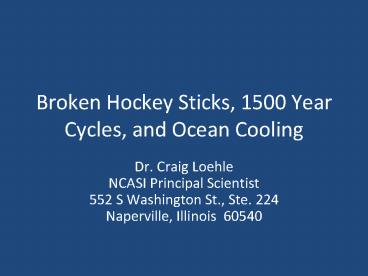Broken Hockey Sticks, 1500 Year Cycles, and Ocean Cooling - PowerPoint PPT Presentation
Title:
Broken Hockey Sticks, 1500 Year Cycles, and Ocean Cooling
Description:
Cause: solar or ocean oscillator (multi-state system) Did they continue? ... Ocean Heat Content (x 1022 J) Recent Temperature Downturn Evident in Hadley Data ... – PowerPoint PPT presentation
Number of Views:105
Avg rating:3.0/5.0
Title: Broken Hockey Sticks, 1500 Year Cycles, and Ocean Cooling
1
Broken Hockey Sticks, 1500 Year Cycles, and Ocean
Cooling
- Dr. Craig LoehleNCASI Principal Scientist552 S
Washington St., Ste. 224Naperville, Illinois
60540
2
The Broken Hockey Stick
- Fundamental assumptions of tree ring
reconstruction are untested - In fact, they are violated
- Ms published online in Climatic Change,Sept. 08
- A Mathematical Analysis of the Divergence
Problem in Dendroclimatology
3
Climate Reconstruction(based largely on tree
ring data)
4
How is it Done?
- Assume linear model ring vs. temperature
- Fit to temperature histories, 20th Century
- Inverse function for past temperature from ring
width / density
5
Signs of Trouble
- Widespread observations of divergence
- good fit up to 1960
- more warming than predicted by tree rings after
1960 - Explanations are speculative
- Individual trees
- may not respond to temperature
- may grow worse when warmer
- (PPT limits)
6
IF Linear Response, Perfect Fit
7
IF Nonlinear Response, Get Truncation (inversion)
Peaks become troughs!
8
IF Ramp Response (no PPT Limitation),Get
Truncation
Ramp results from species maximum growth rate
9
Conclusions
- Linear growth response invalid
- Nonlinear growth explains divergence
- Consequence
- cant guarantee detection of temperatures warmer
than calibration period - Flattens out timeseries reduces mean, range, and
maximum - Cant evaluate MWP or how unusual recent decades
are from linear reconstructions - Cant use nonlinear model because gives nonunique
inverse model
10
The 1500-Year Climate Cycle
- Dansgaard-Oschger events in ice core data
- About 1500 years apart
- Cause solar or ocean oscillator (multi-state
system) - Did they continue?
11
Greenland Data AnalysisUpdated GICC05 ice core
chronology
d18O
Years BP (Yr 0 2000 AD)
12
Greenland Data AnalysisBest-fit model for 30,000
to 37,000 BP(R2 0.36, period 1486 yrs)
d18O (values centered for better estimation of
cycles)
Years BP (Yr 0 2000 AD)
13
Greenland Data AnalysisBest-fit model for 40,000
to 46,000 BP(R2 0.30, period 1598 yrs)
d18O (values centered for better estimation of
cycles)
Years BP (Yr 0 2000 AD)
14
Greenland Data AnalysisBest-fit model for the
Holocene to 8000 BP(R2 0.45, period 1434 yrs)
d18O (values centered for better estimation of
cycles)
Years BP (Yr 0 2000 AD)
15
Best-fit Model 1681- and 1470-Year
CyclesCompared to Loehle Reconstruction (R2
0.68, 0.65 respectively)(confidence intervals
not shown)
1470-yr cycle
Anomaly (C)
1681-yr cycle
Years BP (Yr 0 2000 AD)
16
Best-fit Model to Moberg Low-Frequency Data
(1152-yr cycle, R2 0.69)and Fit to 1470-yr
cycle (R2 0.54)(confidence intervals not shown)
1152-yr cycle
1470-yr cycle
Anomaly (C)
Years BP (Yr 0 2000 AD)
17
Best-fit Model to North Iceland Sea Surface
Temperature(1552-yr cycle, R2 0.20)Data shown
after linear cooling trend removal
Anomaly (C)
Years BP (Yr 0 2000 AD)
18
Oxygen Isotope Data from Central Alps, past 9000
yrsBest-fit models for 2004 AD to 3500 BP and
6500 BP to 8996 BP (1479-yr cycle, R2 0.27,
peak-to-trough amplitude 0.33C)
-delta O-18 ()
Years BP (Yr 0 2000 AD)
19
Temperature inferred from Japanese
CedarBest-free-form-fit (1089-yr cycle, R2
0.28) Best-fit when forced with 1470-yr cycle
looks similar (R2 0.22)
1089-yr cycle
Anomaly (C)
1470-yr cycle
Years BP (Yr 0 2000 AD)
20
Conclusions
- Mean period 1524 yr vs. 1470 yr hypothetical
(3.7 off) - Models, data strongly agree on timing of MWP,
LIA - Supports role for this cycle in recent warming
21
Ocean TemperaturesRecent Trends
- ARGOS float data
- To 700 m depth
- 4.5 years data
- Global coverage
22
Ocean heat content
Ocean Heat Content (x 1022 J)
Calendar Year
23
Ocean heat content smoothed with a 1-2-1
filterand overlaid with a best-fit linear plus
sinusoidal (seasonal) model (R2 0.85)
Ocean Heat Content (x 1022 J)
Calendar Year
24
Ocean heat content smoothed with a 1-2-1
filterand overlaid with linear trend portion of
best-fit model (slope -0.35 x 1022 J/yr)
Ocean Heat Content (x 1022 J)
Calendar Year
25
Recent Temperature Downturn Evident in Hadley Data
26
Conclusions
- Cooling trend over past 4.5 years matches
satellite, surface data - Rate of cooling similar to rate of warming before
2003

